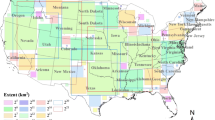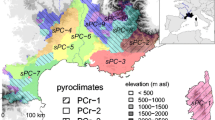Abstract
Management may influence abiotic environments differently across time and spatial scale, greatly influencing perceptions of fragmentation of the landscape. It is vital to consider a priori the spatial scales that are most relevant to an investigation, and to reflect on the influence that scale may have on conclusions. While the importance of scale in understanding ecological patterns and processes has been widely recognized, few researchers have investigated how the relationships between pattern and process change across spatial and temporal scales. We used wavelet analysis to examine the multiscale structure of surface and soil temperature, measured every 5 m across a 3820 m transect within a national forest in northern Wisconsin. Temperature functioned as an indicator – or end product – of processes associated with energy budget dynamics, such as radiative inputs, evapotranspiration and convective losses across the landscape. We hoped to determine whether functional relationships between landscape structure and temperature could be generalized, by examining patterns and relationships at multiple spatial scales and time periods during the day. The pattern of temperature varied between surface and soil temperature and among daily time periods. Wavelet variances indicated that no single scale dominated the pattern in temperature at any time, though values were highest at finest scales and at midday. Using general linear models, we explained 38% to 60% of the variation in temperature along the transect. Broad categorical variables describing the vegetation patch in which a point was located and the closest vegetation patch of a different type (landscape context) were important in models of both surface and soil temperature across time periods. Variables associated with slope and microtopography were more commonly incorporated into models explaining variation in soil temperature, whereas variables associated with vegetation or ground cover explained more variation in surface temperature. We examined correlations between wavelet transforms of temperature and vegetation (i.e., structural) pattern to determine whether these associations occurred at predictable scales or were consistent across time. Correlations between transforms characteristically had two peaks; one at finer scales of 100 to 150 m and one at broader scales of >300 m. These scales differed among times of day and between surface and soil temperatures. Our results indicate that temperature structure is distinct from vegetation structure and is spatially and temporally dynamic. There did not appear to be any single scale at which it was more relevant to study temperature or this pattern-process relationship, although the strongest relationships between vegetation structure and temperature occurred within a predictable range of scales. Forest managers and conservation biologists must recognize the dynamic relationship between temperature and structure across landscapes and incorporate the landscape elements created by temperature-structure interactions into management decisions.
Similar content being viewed by others
References
Albert, D.A. 1995. Regional Landscape Ecosystems of Michigan, Minnesota, and Wisconsin: A working map and classification. USDA Forest Service, North Central Forest Experiment Station GTR NC-178, St. Paul Minnesota.
Bradshaw, G.A. 1991. Hierarchical analysis of pattern and processes of Douglas-fir forests. Ph.D. Dissertation, Oregon State University, Corvallis, Oregon.
Bradshaw, G.A and Spies, T.A. 1992. Characterizing canopy gap structure in forests using wavelet analysis. Journal of Ecology 80: 205-215.
Chen, J., Franklin, J.F. and Lowe, J.S. 1996. Comparison of abiotic and structurally defined patch patterns in a hypothetical forest landscape. Conservation Biology 10: 854-862.
Chen, J., Franklin, J.F. and Spies, T.A. 1995. Growing-season microclimate gradients from clearcut edges into old-growth Douglas-fir forests. Ecological Applications 5: 74-86.
Chen, J., Franklin, J.F. and Spies, T.A. 1993. Contrasting microclimates among clearcut, edge, and interior old-growth Douglas-fir forest. Agricultural and Forest Meteorology 63: 219-237.
Chequamegon National Forest, Washburn Ranger District. 1993. Landscape level analysis, desired future vegetative condition. USDA Forest Service, Park Falls, Wisconsin.
Christensen, N.L., Bartuska,A.M., Brown, J.H., Carpenter, A., D'Antonio, C., Francis, R., Franklin, J.F., MacMahon, J.A., Noss, R.F., Parsons, D.J., Peterson, C.H., Turner, M.G. and Woodmansee, R.G. 1996. The report of the Ecological Society of America Committee on the scientific basis for ecosystem management. Ecological Applications 6: 665-691.
Doak, D.F., Marino, P.C. and Karieva, P.M. 1992. Spatial scale mediates the influence of habitat fragmentation on dispersal success: implications for conservation. Theoretical Population Biology 41: 315-336.
Donovan, T.M., Thompson, F.R. III, Faaborg, J. and Probst, J.R. 1995. Reproductive success of migratory birds in habitat sources and sinks. Conservation Biology 9: 1380-1395.
Forman, R.T.T. and Godron, M. 1986. Landscape Ecology. John Wiley and Sons, New York.
Fortin, M.-J. 1994. Edge detection algorithms for two-dimensional ecological data. Ecology 75: 0956-965.
Fortin, M.-J., Drapeau, P., and Jacquez, G.M. 1996. Quantification of the spatial co-occurrences of ecological boundaries. Oikos 77: 51-60.
Franklin, J.F. 1997. Ecosystem management: an overview. In Ecosystem Management: Applications for Sustainable Forest and Wildlife Resources. pp. 21-53. Edited by M.S. Boyce and A.W. Haney. Yale University Press, CT.
Franklin, J.F. and Forman, R.T.T. 1987. Creating landscape patterns by forest cutting: ecological consequences and principles. Landscape Ecology 1: 5-18.
Gao, W. and Li, B.L. 1993. Wavelet analysis of coherent structures at the atmosphere-forest interface. Journal of Applied Meteorology 32: 1717-1725.
Gardner, R.H., O Neill, R.V. Turner, M.G. and Dale, V.H. 1989. Quantifying scale-dependent effects of animal movement with simple percolation models. Landscape Ecology 3: 217-227.
Gilpin, M.E. and Hanski, I. 1991. Metapopulation Dynamics. Academic Press, New York.
Graps, A. 1995. An introduction to wavelets. Computational Sciences and Engineering 2: 50-61.
Gustafson, E. and Gardner, R.H. 1996. The effect of landscape heterogeneity on the probability of patch colonization. Ecology 77: 94-107.
Hansen, A.J., S.L. Garman, and B. Marks. 1993. An approach for managing vertebrate diversity across multiple-use landscapes. Ecological Applications 3: 481-496.
Hansen, A.J., McComb, W., Vega, R., Raphael, M. and Hunter, M. 1995. Bird habitat relationships in natural and managed forests in the west Cascades of Oregon. Ecological Applications 5: 555-569.
Heinselman, M.L. 1981. Fire and succession in the conifer forests of northern North America. In Forest Succession: Concepts and Applications. pp. 374-405. Edited by D.C. West, H.H. Shugart and D.B. Botkin. Springer-Verlag, New York.
Holling, C. S. 1992. Cross-scale morphology, geometry, and dynamics of ecosystems. Ecological Monographs 62: 447-502.
Horne, J.K. and Scheider, D.C. 1994. Analysis of scale-dependent processes with dimensionless ratios. Oikos 70: 201-211.
Horne, J.L. and Scheider, D.C. 1995. Spatial variance in ecology. Oikos 74: 18-26.
Huey, R. 1991. Physiological consequences of habitat selection. American Naturalist 137: S91–S115.
Hutchinson, G.E. 1953. The concept of pattern in ecology. Proceedings of the National Academy of Sciences 105: 1-12.
Lertzman, K.P, Spies, T.A. and F. Swanson. 1997. From ecosystem dynamics to ecosystem management. In The Rainforests of Home: Profile of a North American Bioregion. pp. 361-382. Edited by P.K. Schoonmaker, B. von Hagen and E.C. Wolf. Island Press, Covelo, CA.
Levin, S. A. 1992. The problem of pattern and scale in ecology. Ecology 73: 1943-1967.
Lovejoy, T.E., Bierregaard Jr., R.O., Rylands, A.B., Malcolm, J.R., Quintela, C.E., Harper, L.H., Brown Jr., K.S., Powell, A.H., Powell, G.V.N., Shubart, H.O.R. and Hays, M.B. 1986. Edge and other effects of isolation on Amazon forest fragments. In Conservation Biology. The science of scarcity and diversity. pp. 257-285. Edited by M.E. Soulé. Sinauer, Sunderland, MA.
MacArthur, R.H. and Levins, R. 1964. Competition, habitat, selection, and character displacement in a patchy environment. Proceedings of the National Academy of Science of the USA 51: 1207-1210.
Miller, D.R. 1980. The two-dimensional energy budget of a forest edge with field measurements at a forest-parking lot interface. Agricultural Meteorology 22: 53-78.
Pearson, S.M., Turner, M.G., Wallace, L.L. and Romme, W.H. 1995. Winter habitat use by large ungulates following fire in northern Yellowstone National Park. Ecological Applications 5: 744-755.
Perry, D.A. 1994. Forest Ecosystems. Johns Hopkins University Press, Baltimore, Maryland.
Pickett, S.T.A. and White, P.S. (eds.). 1985. The Ecology of Natural Disturbance and Patch Dynamics. Academic Press, New York.
Reed, R.A., Johnson-Barnard, J. and Baker, W.L. 1996. Contribution of roads to forest fragmentation in the Rocky Mountains. Conservation Biology 10: 1098-1106.
Stage, A.R. 1976. An expression for the effect of aspect, slope, and habitat type on tree growth. Forest Science 22: 457-460.
Swanson, F.J., Kratz, T.K., Caine, N. and Woodmansee, R.G. 1988. Landform effects on ecosystem patterns and processes. Bioscience 38: 92-98.
Swanson, F.J., S.M. Wondzell, and G.E. Grant. 1992. Landforms, disturbance, and ecotones. In Landscape Boundaries: Consequences for Biotic Diversity and Ecological Flows. pp. 305-323. Edited by A.J. Hansen and F. di Castri. Springer-Verlag, New York.
Turner, M.G., Hargrove, W.W., Gardner, R.H. and Romme, W.H. 1994. Effects of fire on landscape heterogeneity in Yellowstone National Park, Wyoming. Journal of Vegetation Science 5: 731-742.
Turner, M.G. (ed.) 1987. Landscape heterogeneity and disturbance. Springer-Verlag, New York.
Weber, L.H., El-Sayed, S.Z., and Hampton, I. 1986. The variance spectra of phytoplankton, krill, and water temperature in the Antarctic Ocean south of Africa. Deep-Sea Research 33: 1327-1343.
Wiens, J.A. 1989. Spatial scaling in ecology. Functional Ecology 3: 383-397.
Wiens, J.A., N.C. Stenseth, B. Van Horne, and R.A. Ims. 1993. Ecological mechanisms and landscape ecology. Oikos 66: 369-380.
With, K.A., Gardner, R.H. and Turner, M.G. 1997. Landscape connectivity and population distributions in heterogeneous environments. Oikos 78: 151-169.
Xu, M., Chen, J. and Brookshire, B.L. 1997. Temperature and its variability in oak forests in southeastern Missouri Ozarks. Climate Research. In press.
Author information
Authors and Affiliations
Corresponding author
Rights and permissions
About this article
Cite this article
Saunders, S.C., Chen, J., Crow, T.R. et al. Hierarchical relationships between landscape structure and temperature in a managed forest landscape. Landscape Ecology 13, 381–395 (1998). https://doi.org/10.1023/A:1008097011008
Issue Date:
DOI: https://doi.org/10.1023/A:1008097011008




